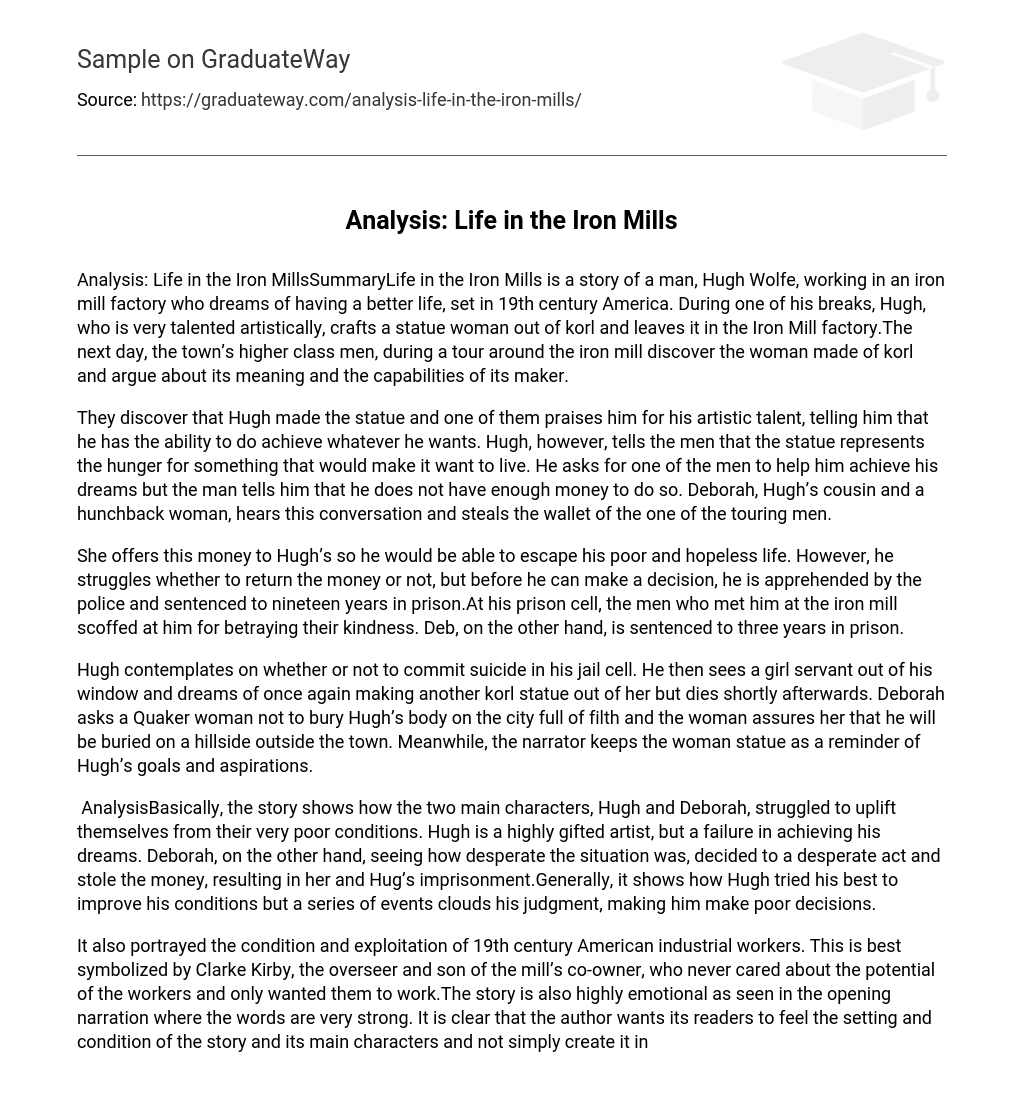Life in the Iron Mills is a story of a man, Hugh Wolfe, working in an iron mill factory who dreams of having a better life, set in 19th century America. During one of his breaks, Hugh, who is very talented artistically, crafts a statue woman out of korl and leaves it in the Iron Mill factory.The next day, the town’s higher class men, during a tour around the iron mill discover the woman made of korl and argue about its meaning and the capabilities of its maker.
They discover that Hugh made the statue and one of them praises him for his artistic talent, telling him that he has the ability to do achieve whatever he wants. Hugh, however, tells the men that the statue represents the hunger for something that would make it want to live. He asks for one of the men to help him achieve his dreams but the man tells him that he does not have enough money to do so. Deborah, Hugh’s cousin and a hunchback woman, hears this conversation and steals the wallet of the one of the touring men.
She offers this money to Hugh’s so he would be able to escape his poor and hopeless life. However, he struggles whether to return the money or not, but before he can make a decision, he is apprehended by the police and sentenced to nineteen years in prison.At his prison cell, the men who met him at the iron mill scoffed at him for betraying their kindness. Deb, on the other hand, is sentenced to three years in prison.
Hugh contemplates on whether or not to commit suicide in his jail cell. He then sees a girl servant out of his window and dreams of once again making another korl statue out of her but dies shortly afterwards. Deborah asks a Quaker woman not to bury Hugh’s body on the city full of filth and the woman assures her that he will be buried on a hillside outside the town. Meanwhile, the narrator keeps the woman statue as a reminder of Hugh’s goals and aspirations.
AnalysisBasically, the story shows how the two main characters, Hugh and Deborah, struggled to uplift themselves from their very poor conditions. Hugh is a highly gifted artist, but a failure in achieving his dreams. Deborah, on the other hand, seeing how desperate the situation was, decided to a desperate act and stole the money, resulting in her and Hug’s imprisonment.Generally, it shows how Hugh tried his best to improve his conditions but a series of events clouds his judgment, making him make poor decisions.
It also portrayed the condition and exploitation of 19th century American industrial workers. This is best symbolized by Clarke Kirby, the overseer and son of the mill’s co-owner, who never cared about the potential of the workers and only wanted them to work.The story is also highly emotional as seen in the opening narration where the words are very strong. It is clear that the author wants its readers to feel the setting and condition of the story and its main characters and not simply create it in our imagination.
The highly descriptive language is effective in evoking emotions.Moreover, the story has a strong sense of realism as it portrayed the harsh realities of life through the prostitutes and oppressed workers, among others. It shows the will of a person to demand change. However, the reality can only be changed if it is directly confronted.
The person, in the form of Hugh’s, has goals and seemingly unlimited aspirations but is forced to forego those dreams as he is basically controlled by economic forces and economic conditions.There are also symbols of feminism in the story in the forms of the Quaker woman and the korl statue. However, the korl statue, which has a “face of a starving wolf, best symbolizes the hunger of Hugh, who is unable to determine what he is hungry for and who is unable to express what he really wants.Works CitedDavis, Rebecca.
Reference
- Life in the Iron Mills. Bedford, Virginia: Bedford Books, 1997.





